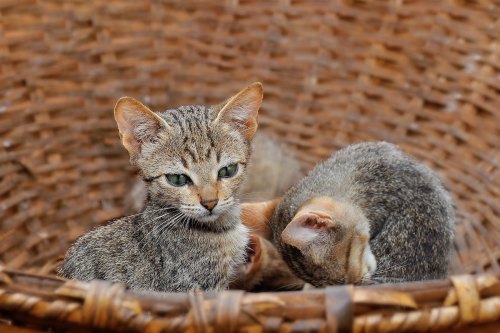
Polydactyl cats: The term sounds exotic — almost like it should be used to describe an amphibian. The unusual term is fitting for something of an odd condition.
A polydactyl cat has a congenital physical anomaly. In layperson’s terms, this means that a cat is born with the condition. They can’t suddenly develop the condition.
The condition causes the cat to have more toes than usual on one or more of their feet. Cats usually have 18 digits or toes: Five on each of the front two paws and four on each of the back two. A cat typically inherits the trait. You may be alarmed if you have a polydactyl cat or notice a kitten with too many toes. Are they in danger? Is this condition common? Here’s what to know about the polydactyl cat, including their health outlook.
Are polydactyl cats rare?
A polydactyl cat’s condition may be considered an anomaly, but they’re not rare, particularly in certain areas of the world: Western England, Wales, Canada, and the Eastern U.S. It’s unclear how many polydactyl cats exist, though the condition is genetic. If a parent has the condition, a kitten could, too. There are three types of polydactyl cats:
- Preaxial: This type is the most common and means that a cat has extra toes that may resemble a thumb.
- Postaxial. The cat has extra toes on the outside of the paw (the pinky side).
- Mesoaxial. This type of polydactyl cat is the least common and occurs when a cat has extra toes in the middle of the paw.
What breeds of cats are polydactyl?
Any cat breed can be polydactyl, but Maine Coon cats may have greater odds of having more digits. Not all cats with parents that have the gene will become polydactyl. The parents also don’t have to have the condition to create a polydactyl kitty. However, the gene exists somewhere in the kitten’s lineage, and it’s far more likely to occur in cats with at least one polydactyl parent.
What causes polydactyl cats?
Polydactyl cats have a condition caused by a dominant gene mutation. A gene mutation affects a cat’s DNA, creating something different — and extra toes are certainly different.
Typically, pet parents will see extra toes on the front paws, and it’s not typical for every foot to have additional digits. You might see as many as nine toes on a paw. The record for total toes is 28, according to the Guinness Book of World Records. The mark is held by Jake, a male ginger tabby cat who lived in Bonfield, Ontario, Canada, with proud parents Michelle and Paul Contant. His vet counted all 28 digits in 2002.
What is the life expectancy of a polydactyl cat?
Polydactyl cats don’t have a different life span than cats with the usual number of toes. On average, both types live 15 years if they stay indoors, though it varies by breed and other health conditions.
The biggest issue fur parents of polydactyl cats will likely have is trimming nails. Cats usually don’t like nails trimmed, to begin with, so the faster a person can go, the better. You might consider pawning it off on a veterinarian or groomer (though cats aren’t always a fan of either of those, let alone the car, bus, or train rides to get there).
If you count more than 18 digits on your feline friend, have your vet take a look. Even though polydactyl cats can live healthy lives, radial hypoplasia is another reason a cat may have extra toes. It is also inherited. These toes present right next to the normal toes and cause large, flat feet. Cats with this condition can also live every day, happy lives but may be a bit shaky. A cat parent and veterinarian will want to monitor it throughout a kitty’s life.
You can help your polydactyl cat live a happy life by:
- Attending regular vet checkups
- Staying up to date on vaccinations
- Administering monthly preventatives
- Leaving out plenty of water
- Feeding them a healthy diet of mostly cat food
- Keeping toxic food, plants, and household items out of reach
- Having your cat stay indoors, where they are safe from cars and predators
- Providing opportunities for physical and mental enrichment, like cat trees, wand toys, and crinkle balls
- Grinning and bearing it as you clip their nails (or paying someone else to do the dirty work)
Polydactyl cats have extra toes. Though the condition may seem strange, it’s not that uncommon. It’s an inherited gene mutation, so cats with polydactyl parents are likelier to have the condition. Don’t worry if you notice too many toes on your cat. Polydactyl cats can live normal, healthy lives and don’t have a shorter life span than their non-polydactyl peers.
Have your vet check out their feet to make sure everything checks out and that it’s not a flag of another condition. Otherwise, treat your kitty the way you would any other. Provide plenty of love, food, water, and enrichment. Cutting toenails will be slightly less fun (or more if you enjoy being hissed at), but you can always pass the buck — that’s what groomers and your neighborhood veterinarians are for.
Editors' Recommendations
- This is why cats pee on clothes (and how you can save your wardrobe in the future)
- These useful tips can help you support your senior cat’s health
- Why do cats fight? They’re not just being jerks
- Why do cats roll in dirt? 10 reasons for their dust bath
- Why do cats cover their face when they sleep? This adorable behavior, explained